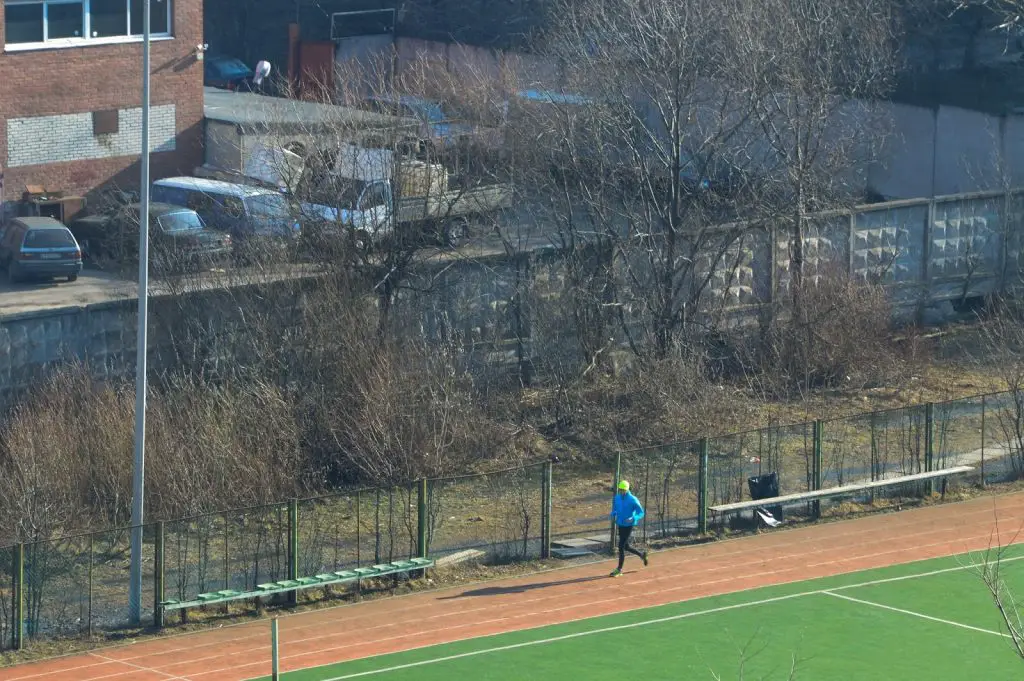4 Top Benefits Of Aerobic Base Training For Marathon Runners
Aerobic base training is easily the most important part of every endurance athlete’s training plan. Apart from improving overall level of fitness, it also prepares the body to tolerate more workload later in the season.
For marathon runners in particular this period is a perfect opportunity to gradually increase the total duration of their runs and overall weekly mileage.
Such approach will help to prevent many injuries associated with running long distances and create a foundation for a healthy season.
Aerobic base training benefits
First things first. The word ‘aerobic’ means that the body generates energy mostly by using oxygen to burn fat. This process takes place in mitochondria – small powerhouses that generate energy, located in muscle tissues.
The main focus of aerobic base training phase is prolonged low intensity exercise. In other words, lots of easy running primarily in zones 1 and 2. However, as the base training phase progresses, athletes can also add some moderate intensity and strength component to optimize results even more.
I agree, it may sound a bit counter-productive. How on earth an athlete would get faster by training easy? Well, scientifically speaking
Aerobic base training is all about increasing the mitochondrial density to make muscles more efficient.
Over time focus on low intensity sessions will also train the body to be more effective at supplying oxygen to working muscles, which translates to even more speed and better endurance.
As the total duration of sessions increase and the athlete accumulates ‘aerobic base’, he will be able to run faster using the same amount of energy. In the end, going slower does make athletes faster.

Benefit #1 – More speed and better muscle efficiency
What is this mitochondrial density?
Aerobic base training promotes the growth of mitochondria in Fast Oxidative/Glycolictic (or Type IIa) muscle fibers, turning them more similar to slow twitch (oxidative) muscle fibers and allowing energy to be produced quicker. As a result, over time effort that feels ‘easy’ will start to become quite fast.
Don’t let the word slow twitch or easy effort confuse you. For an elite marathoner ‘easy’ effort is around 4:00 minutes per kilometer at which point the athlete still uses primarily slow twitch muscle fibers.
To put things into perspective, 4:00 min/km is easy pace for an elite runner. It’s a sub 2:50 hour marathon pace, which most people are able to maintain for less than 10 minutes before needing to catch a breath.
In fact, more than 90% of the distance in endurance races (half-marathon and above) is run in aerobic mode. Therefore, having efficient muscles is important to save as much energy as possible to be able to maintain the speed for longer.
Benefit #2 – Improved recovery
Aerobic base training also develops capillary network, which allows to supply blood to the muscles more effectively.
At around 110-130 beats per minute the amount of blood the heart pumps out is at its maximum. Beyond that point it’s only the heart rate that increases. By spending a lot of time in this zone the heart “stretches” and is able to pump out more blood into the muscles.
In addition to making muscles endure and efficient, mitochondria also utilize fatigue accumulated during high intensity training. So, overall
Large aerobic base speeds up recovery, as the muscles are able to utilize lactic acid more efficiently.
This allows to tolerate more training load and prepares athlete’s body for more intense training later in the season.
Benefit #3 – Improved form and economy
Running, like cycling, swimming and kayaking is a cyclic sport. And constant repetition of the same movement at low intensity helps to build a mind-body connection. This allows athletes to better focus on perfecting the form and optimizing it.
Good running technique reduces unnecessary braking forces and improves the overall economy. The better the economy, the more energy athlete can dedicate to running faster.
Also, since this kind of training uses fat for fuel and doesn’t accumulate much fatigue, body burns a lot of fat and keeps itself lean. This improves running economy even more, as the body has to carry less excess weight.
Some say dropping 1-2 kilograms of excess fat can improve the overall pace by as high as 10-15 seconds per kilometer.

The Resilient Athlete
A Self-Coaching Guide to Next Level Performance in Sports & Life
Are you aiming to become a resilient athlete who is able to withstand any pressure? Be able to jump on any opportunity? Take any challenge life throws at you head on?
Then this book is for you.
Learn moreBenefit #4 – Increased overall strength
Prolonged exercise builds strength in ‘supportive’ or ‘stabilizing’ muscle groups, like calves, hips, glutes and core. When mileage is built up gradually, these muscles have enough time to properly recover and grow stronger, which will prevent injuries and also improve running economy.
In addition to that, off-season and early season is the only time when endurance athletes can really focus on building maximum strength. Since this kind of training requires a lot of time to recover from, it’s not really possible to include it during the season.
Throughout the season due to demands of endurance training athletes actually lose maximum strength. So, it’s important to include it during aerobic base training phase to maintain the ability to run fast.
Sample 4 week advanced base building schedule
Generally, it’s good to start with some 20 to 30 hours of aerobic work in zones 1 & 2 only to safely build up the weekly distance and ease into the training.
After that, it’s good to start including a bit more intensity to improve strength, muscle economy and running form.
The sample plan below shows 3 sessions that you can add to your training to stimulate further muscle adaptation. This plan takes into account an athlete that has already completed 20-30 hours of easy running in Zones 1 & 2 and is comfortable running 30 kilometers per week.
| Weeks | #1 | #2 | #3 |
| W1 | 7K hilly + strides | 7K easy + 10min Z3 | 12K easy + strides |
| W2 | 8K hilly + strides | 8K easy + 15min Z3 | 13K easy + strides |
| W3 | 9K hilly + strides | 9K easy + 20min Z3 | 14K easy + strides |
| W4 | 5K hilly + strides | 5K easy + 10min Z3 | 10K easy + strides |
Hilly runs
By far the best way to improve strength in run-specific muscles and improve running form is to include hilly runs. Running uphill targets hamstrings, glutes and hips, as well as promotes forward lean and correct foot placement.
It’s best to choose a hilly route where you can comfortably keep the heart rate in Zone 2, instead of running up and down the same hill.
Strides
Strides are short speed pickups from easy running to a very intense effort (around 90% of maximum speed). These speed pickups are kept very short – up to 15 seconds maximum – and create minimum fatigue. Therefore, it’s good to include a couple of these after every ‘easy’ run.
Strides help to build neuromuscular strength and promote mitochondria growth in fast-twitch muscle fibers that are not involved during Zone 1 & 2 efforts.
Tempo efforts
Tempo efforts are done at Zone 3 effort, which is sometimes referred to as ‘no-man’s land’.
That’s because Zone 3 in itself is a moderate intensity level and many runners make the mistake of doing all of their training in that zone. Over time this strategy accumulates a lot of fatigue and brings minimum benefit.
The key to Zone 3 training is interval method. Adding one or several long Zone 3 interval (10 to 30 minutes) to an easy run will help to utilize larger share of the muscle tissue and stimulate even more mitochondria growth, while adding minimum fatigue.
Related: Train Smart – A Practical Guide to Exercise Heart Rate Zones
Did you find this information useful? Share the post with others using the buttons below.
My first marathon training progress
Update: I ran my first marathon and it was a roller coaster of emotions. Read my race report here, if you’re interested.
I started my formal training a couple of months ago and am still in aerobic base training phase. During April and May together I logged just over 200K of easy running, which is less than I planned originally.
Still, I feel I’m in good shape now. I compensated some of the running with cycling every day to work.
This adds quite a lot of disciplined low heart rate training to my plan. The heart rate on a bike rarely jumps over 140 and usually stays around 120-130 beats per minute. Everything that I need to build fitness and endurance.

My weekly mileage is now consistent 35-40 kilometers spread across 5-6 runs. I try to run more frequently to improve the running form and minimize accumulated fatigue.
Jumping a little ahead of myself, below is a summary of how my base training progressed:
| Month | Duration | Activities | Progress (on ~6km run) |
| Jan | 10 hours | run | Jan 13 – pace 5:24, av. HR 147 |
| Feb | 9.5 hours | run/ski | Feb 23 – pace 5:23, av. HR 144 |
| Mar | 13 hours | run | Mar 9 – pace 5:16, av. HR 145 |
| Apr | 18.5 hours | run/bike/kayak | Apr 17 – pace 5:08, av. HR 149 |
| May | 29 hours | run/bike/hike | May 11 – pace 5:12, av. HR 143 |
| Jun | 37 hours | run/bike/swim | Jun 1 – pace 4:59, av. HR 142 |
| Jul | 40 hours | run/bike/swim/kayak | Jul 6 – pace 4:48, av. HR 145 |
Going forward I plan to add some intensity to my training, to work on both endurance and strength, while still keeping aerobic base training going. My plan is to add the following to my training plan:
- Long intervals or steady runs (Zone 3) of up to 10K to work on my marathon pace
- Long runs at low heart rate to be able to tolerate long distances (Zones 1 & 2)
- Short easy or recovery runs (Zones 1 & 2)
- Hill repeats or short intervals of up to 1K (Zones 3 & 4)
I may not include all of these sessions into every week, but rather keep my training plan flexible. The most important sessions for me now are long runs and marathon pace runs. Depending on my recovery, I will see if I want to add some intervals already now to work on power and speed.
That’s it for now. In the meantime, happy training!

Have an opinion? Share via links below and tag @theathleteblog
Tags In
Andrejs Birjukovs
GET A FREE TRAINING PLAN
Subscribe to my email list and get access to a free 4-week “back in shape” training plan
You’ll also get two full-body strength sessions and some other goodies!

How did I get here?
Hey there! My name is Andrejs and I am here to inspire, entertain and get you fit for any adventure.
I went from being an over trained pro athlete to an endurance coach sharing how to listen to your body and live life to the fullest.
Traveling, new sports & activities brought new meaning to my training and made it much more effective, fun and enjoyable. And I'm here to help you do the same.


